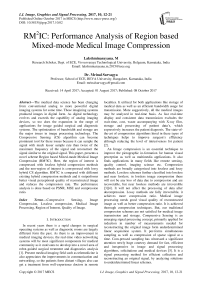RM2IC: Performance Analysis of Region based Mixed-mode Medical Image Compression
Автор: Lakshminarayana. M, Mrinal Sarvagya
Журнал: International Journal of Image, Graphics and Signal Processing(IJIGSP) @ijigsp
Статья в выпуске: 10 vol.9, 2017 года.
Бесплатный доступ
The medical data science has been changing from conventional analog to more powerful digital imaging systems for some time. These imagining systems produced images in digital form. As digital technology evolves and exceeds the capability of analog imaging devices, so too does the expansion in the range of applications for image guided surgical and diagnostic systems. The optimization of bandwidth and storage are the major issues in image processing technology. The Compressive Sensing (CS) algorithm can become prominent tool for these issues because it can sample the signal with much lesser sample rate than twice of the maximum frequency of the signal and reconstruct the signal similar to the original signal. This paper, presents a novel scheme Region based Mixed-mode Medical Image Compression (RM2IC). Here, the region of interest is compressed with lossless hybrid compression methods and the non-region of interest is com-pressed with lossy hybrid CS algorithm. RM2IC is compared with different existing hybrid compression methods and it outperforms better visual perceptional quality of reconstructed image and reduces the compression rate. The performance analysis is done based on PSNR, MSE and compression ratio.
Compressive Sensing, Image Compression, Lossless compression, Medical Image Processing, Region of Interest, Quality of Image
Короткий адрес: https://sciup.org/15014233
IDR: 15014233
Текст научной статьи RM2IC: Performance Analysis of Region based Mixed-mode Medical Image Compression
In recent years there is a rapid changes in surgical operating systems as well as diagnostic rooms are largely different form the past. As there is an improvement in medical imaging devices, the real-time video networking systems will be most significant components for medical community as it motivates to develop into a novel area of robot-guided surgical treatment and diagnostics analysis [1]. Present medical imaging field such as telemedicine is also appreciates the improvements in communication and networking, so the patients form distant villages also can get a treatment from well-experience doctors in remote localities. It utilized for both applications like storage of medical data as well as an efficient bandwidth usage for transmission. More suggestively, all the medical images may be analyzed in real-time basis. As fast real-time display and consistent data transmission excludes the wait-time, cost, waste accompanying with X-ray film, storage and processing of patient data’s, which expressively increases the patient diagnosis. The state-of-the-art of compression algorithms hired in these types of techniques helps to improve surgeon’s efficiency although reducing the level of intrusiveness for patient [2].
An Image compression is an essential technique to improve the pictographic in-formation for human visual perception as well as multimedia applications. It also finds applications in many fields like remote sensing, quality control, imaging science etc. Compression methods are broadly categorized into lossless and lossy methods. Lossless schemes further classified into lossless and near lossless; in lossless image compression there will not be any loss of data due to compression and are recoverable, but near lossless methods are irreversible [3][4]. It will not affect the processing of data after decompression. Lossy methods are fully irreversible, it achieves more compression ratio. Medical image processing needs good visual quality of reconstructed image as well as better compression ratio. It is achieved thorough compression techniques. But, our traditional compression schemes are not satisfied for medical image transmission and storage. Compressive Sensing is an emerging signal processing concept, primarily applied for reduction in number of measurements needed for reconstructing the original image form underdetermined linear acquisition system. It per-forms simultaneous sampling as well as compression of sparse signal at a time. Com-pressed sampling has witnessed a significant attention newly huge courtesy demand for fast, efficient and inexpensive in image and signal processing algorithms, solicitations and medical devices [5]. It is a signal processing method for efficient collection and reconstructing an original signal, by analyzing solutions to underdetermined linear schemes.
Therefore, existing schemes where many compression techniques being presented in recent years for evolving up with novel approaches of compressive sensing. All the methods discussed have a significant favorable point of study and approve while related with restrictions and constraints too. The issues relating to current studies are discussed concisely in the following segment. This paper, presents a novel scheme Region based Mixed-mode Medical Image Compression. It achieves better compression rate as well as a good visual perception of reconstructed images. It over-comes the optimized dimensional reduction by sparsity into NROI and hence, medical image transmission over limited bandwidth network. The rest of this paper is organized as follows. Section II discusses the many related works done by various re-search on compression sensing algorithm. Section III explains about the problem identification. Section IV talked about the proposed technique. Part V took after by discourse of adopted research methodology. Section VI gives the algorithm implementation. Section VII continued by comparative performance analysis of the acquired outcomes. At last, the commitments of paper will give the future research work is summarized in Section VIII.
A Today, in different procedure and diagnostic of medical imaging, various kinds of images are produces mainly, the Computed Tomography (CT), Mammography, Direct Radiography, Molecular Imaging, Ultrasound, Nuclear Imaging, Tomosynthesis, Digital X-Ray, Elastography, Positron Emission Tomography (PET) and MRA etc. Our previous related work has already explained numerous existing works to carry out the compressive sensing over multimedia [6] with a clear description of research gap.
This segment, we review some more relevant research work towards compressive sensing considering more complexities. Pavithra et al. [7] represented a medical image using hybrid compressive sensing method. Here, DWT is implemented for sparse signal. Where the signal is represented as low and high band coefficients, then finally the different image reconstruction schemes are used for low and high frequency components. Ponuma et al. [8] presented a hybrid compression scheme to decrease the computational complexity of the system as well as the memory requirements. It uses the arithmetic and block based CS scheme to reduce the memory requirements. Atar et al. [9] develops the data compression method using compressive sensing. CS is signal processing methodology. It measures fewer number of samples to reconstruct the original signal. It achieves better compression rate and good perceptional quality of image using orthogonal matching pursuit (OMP) schemes. Deriche et al. [10] pro-poses a novel framework for image compression using compressive sensing algorithm. The ℓ1-minimization method is applied to reconstruct the original signal. The results shows that, the presented schemes outperforms current methodologies over various types of images. Obermeier et al. [11] presented an advanced imaging methodology for utilized in mixed mode digital breast tomosynthesis. Where CS is applied to reconstruct the dielectric constant along with conductivity of breast cancer utilizing minimum number of measurements.
Bernal et al. [12] demonstrates the hybrid compression scheme to acquire and re-construct original image measuring minimum number of samples. It also reduces the complexity of the system and reduce the memory space. Gorthi et al. [13] integrates the dual tree wavelet transform and compressive sensing method to eliminate speck-les in reconstructed image. It outperforms an efficient scheme to reduce the computational cost, time and memory of the system. Zhang et al. [14] analysed the performance of sparsity on SAR images using compressive sensing algorithm. Where the quantitative method is adopted to enhance the compression rate. The limitation of this method is it cannot enhance the side lobes of the different kind of images. Thapliyal et al. [15] simulated the data compression scheme using discrete cosine trans-form and linear predictive coding method. It also uses the compressive sensing method to reconstruct the original data at sink node in a wireless sensor network. The out-come illustrations that, this system deliver acceptable compression rate of examined data. Yang et al. [16] done a realistic work where compressive sensing algorithm is used to SAR tomography images. It uses a hybrid of CS and Cramer-Rao bound estimation schemes to estimate the approximate realistic radar picture better than other conventional schemes.
Sevilla et al. [17] performed the dimensionality reduction for hyper spectral images using spectral compressive sensing method. It also reduces the computational complexity of the system, along with less mean square error. The proposed paper introduces the mixture of both lossless and lossy compression method to achieve better compression rate as well as a good visual perception of reconstructed images. It uses the traditional lossless algorithms are applied to the region of interest part of a picture, and the reaming portion is compressed by using compressive sensing method. It over-comes the optimized dimensional reduction by sparsity into NROI and hence, medical image transmission over limited bandwidth network.
-
III. Problem Identification
This section deals with the issues identified after reviewing various existing research works related to the hybrid medical image compression using compressive sensing. A closer look towards the current compressive sensing techniques is utilized to achieve more compression on critical image regions, even knowing that it is lossy compression method. Hence, the current usage of CS is not for analysis of various complex medical images and also to achieve faster response time. The delay in current research works address lesser quality of the image as well as large algorithm processing time. These issues are addressed in proposed work. All the existing works achieve image compression has a certain limit, but it also some specific foremost loopholes presents. As the outcome of image analysis cannot be associated with error-proneness, hence more emphasis is formulated over the open research problems. Some of limitation or issues of medical image compression are discussed here are:
-
• In the existing work more are less everyone uses the conventional image compression methods to compress the images. But medical image analysis is suffering from storage and transmission as well as limited bandwidth etc. Less efficient techniques are found in current literature work toward hybridizing schemes in innovative directions. It will decreases the image cost, reduces the dimension of image and improves the quality of images.
-
• Accurate diagnosis of illnesses and abnormality circumstance needs both region-of-interest and non-region-of-interest portion of recovered medical image with less cost and less time. Unluckily, the existing research works are not focusing on nonregion part of image and not found. So this point considers this fact to carry out of medical image compression and reconstruction using hybrid technology.
-
• We reviewed various existing methods, these techniques achieves greater compression rate on various medical images. But the pitfalls of the current system are, i) assessing the similar type of dataset, ii) there is no comparative study and iii) image analysis uses less number of performance parameters etc. It will suggest towards future research direction. i.e, very less amount of studies towards standard medical image compression.
-
• Less number of studies towards image reconstruction to achieve good quality of reconstructed image as well as greater dimensionality reduction on both ROI part and Non-ROI part of image.
-
IV. Proposed Technique
The proposed work is a continuation of our previous studies [18][19][20][21]. Where compression of medical image has been refined to get better compression performance. This part of study especially focused on the region based medical image while performing a novel compression technique. We present a novel framework for Medical Image Compression using Compressive Sensing in this implementation paper in the direction to improve out previous work towards increasing better compression on both diagnostically important region as well as the non-diagnostically region. The design of a novel framework of RM2IC is shown in fig.1. Where we used the different medical images as inputs for analyzing our proposed scheme. Here, the original image is segmented using segmentation algorithm. The image is divided like ROI part of image as well as Non-ROI part of image. The ROI part of image is compressed using conventional lossless compressive sensing methods, as well as the Non-ROI part of image is compressed using a lossy compression techniques like Compressive sensing scheme. Then it is quantized and packetized then transmitted in a communication channel. At the receiving end the compressed image is decompressed using decompression algorithms. Finally, we will get the original transmitted medical image with better quality as well as good compression rate.
In this scheme, firstly, we will collect all the input images in a database. Then applying the pre-processing operations to all the medical images. Then, the image is divided into two different part: the background of an image and the region of interest of the image. The central part is ROI, i.e. diagnostically important region is compressed with the tradition method like Huffman and arithmetic encoding schemes to achieve better image quality of ROI part. Then, compressive sensing algorithm is applied to N-ROI part. It also achieves better reconstruction of an image compared to traditional schemes. The simulated system reduces the HTV of chosen image x exposed to the reliable information limitation [22]. Without the cost of simplification, assume the limited slope Дx is constrained by one through the full image. Scientifically, we resolve, min x x
s.t Ф x = y
Whereas Φ is Fourier coding matrix for minimized sampling, y is the under sampled k -space information, HTV is well-defined as,
||x L, = E f ( \ x ) (2)
i , j
Where
^ i,J x\ , Ayx < T
-
1, Ayx ^T
f (A^ x ) = 1
as well as T < 1 is a stable threshold.
It is shown that the projected HTV comprises TV as a clear case when τ = 1 . Such as τ reaches zero, HTV converts the l 0 of the image ascent. In place of any 0 < τ < 1 , HTV fusions l 1 and l 0 reliant on the natural gradient at separate places and be able to be viewed as a mixture l 1 - l 0 of the image ascent [23]. The cost of τ controls the assistances on or after l 1 or l 0 correspondingly [23]. For large τ , HTV is quicker to a convex task and therefore consumes improved convergence to the universal minimum. We have demonstrated, we resolve the unrestrained optimization issues in its place:
( mini y -ф x l I + A H L.K )
Where the regularization or normalization parameters λ is selected to stability the impact of each duration. Gradient descent technique [24] is recycled to an appliance of the projected HTV minimization process. In every repetition, the image at pixel (i, j) is restructured by, k+1 k k k
Xj = Xy- ЦДЛ x)
Whereas hkk) is the objective function well-defined in Eq. (7), k signifies the repetition index, and μ is the gradient background issue. The grade of the HTV is assumed as the quantity of,
A. J U L,=
D, D, D, i----------Г + i----------Г — i-------------Г — iг
IVxj ^xj ^x.—.,,^
Where V x j< T
above entire pixels, where a minor ε is extra to the denominator to escape separating by zero. After the similar optimization algorithm (e.g. gradient descent here) is utilized, the computational difficulty of the projected technique is around the similar as that of TV.
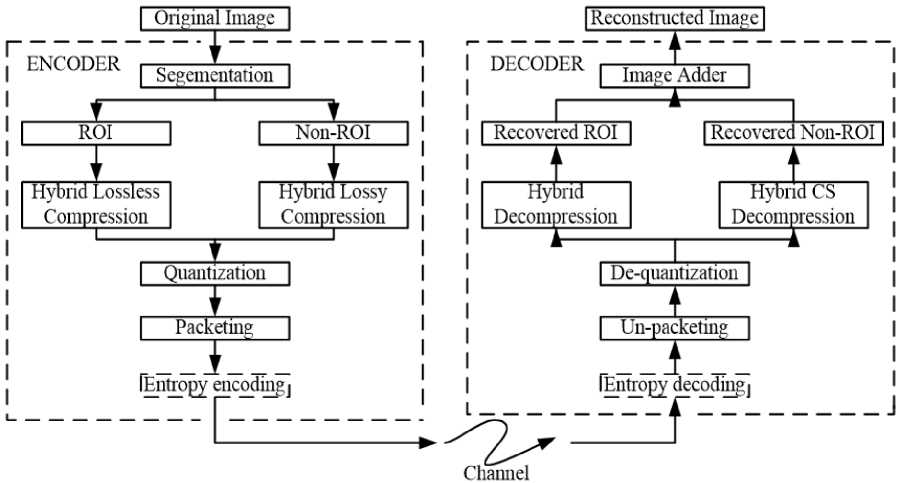
Fig.1. Block diagram of the Proposed RM2IC Framework.
But, due to the non-convexity of HTV, a correct early estimate is needed for the conjunction to a great superiority image [25]. The core objectives of proposed study are i) To present a non-iterative technique for compressing a radiological image, ii) To introduce a modelling of a combinatorial approach to accomplish higher compression performance. RM 2 IC is designed on the concept of implementing lossy compression scheme of compressive sensing on non-ROI while it applies lossless compression schemes on ROI portion of the image. This methodology is undertaken to ensure a better equilibrium between compression performance and image quality of output signal. Next section discusses the research methodology being adopted to execute the RM 2 IC.
-
V. Research Methodology
The implementation of the projected scheme is carried out considering analytical research methodology. Following are the stages that have been accomplished:
-
A. Preparing the Input Images
For better result evaluation, we consider to make discrete classes of medical images from the dataset. The images are converted to grayscale followed by an increase in precision by double. The prospective study of RM 2 IC considers compressing both ROI and non-ROI part for the given image. Hence, ROI is obtained from the input image and it is further confirmed using a bounding box. The non-ROI part of the image is retained as it is in this phase (Fig.2).
Selection of ROI
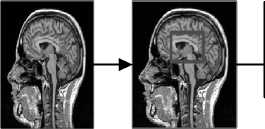
Original Image
Fig.2. Preparing the input images.

ROI

Non-ROI
-
B. Compression and Reconstruction Method
The next part of the study is to perform compression on a defined compression range. As ROI is considered to be region of clinical importance so the proposed study uses JPEG2000, Run Length Encoding (RLE), and Huffman coding in order to per-form lossless compression. The proposed study also emphasizes non-
- ROI part and hence it applies lossy compression scheme of compressive sensing. For this purpose, a coefficient size is defined for compressive sensing and the algorithm works towards generation of compressed bits (Fig.3). All the unique pixel information is retained in this stage followed by conventional encoding mechanism of run length encoders and Huffman encoder.
Lossless Compression Methods
ROI

JPEG 2000 + Huffman + RLE + Arithmetic

Quantization / Packeting
Compressed Image
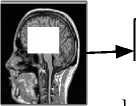
CS [Normalization, DWT (Ψ), Measurement Sampling (Φ)]
Lossy Method - Compressive Sensing Input Image
Fig.3. Performing the Compression method.
The reconstruction of medical is done using the following methods. Here, the compressed image is performed the un-packetization and de-quantization methods. At initially, the bit error loss will be checked for received signal. If the bit loss occur means, perform the regrouping measurement matrix method. If not, perform hybrid compression algorithm for both ROI as well as
Non-ROI part of image. Then finally apply the discrete wavelet transform and de-normalization scheme. Finally, we will get the decompressed ROI part as well decompressed Non-ROI part of image. Both of this image is added using adder circuit. Finally we will get the original medical image (Fig.4).
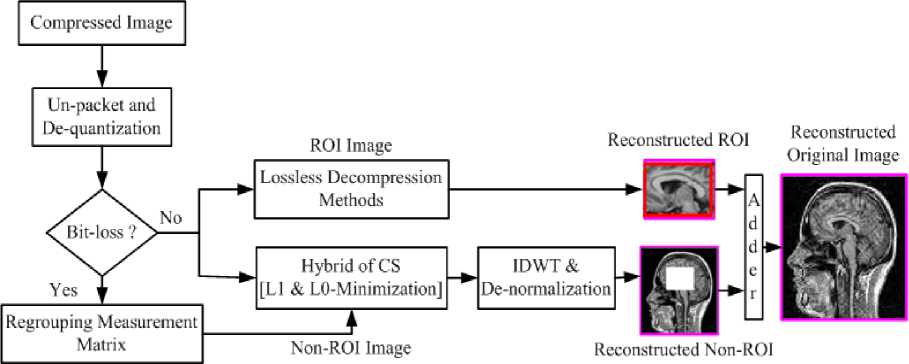
Fig. 4. Performing the Reconstruction method.
-
VI. Algorithm Implementation
The proposed algorithm is responsible performing compression of the medical images using its hybridized approach. The algorithm takes the contribution of Iroi / Inroi (image for region of interest and non-region of interest), M (size of coefficient for Compressed Sensing), i (row), j (column), σ (Compression ratio), which after processing yields output of Irec (reconstructed image).
The steps required in proposed RM 2 IC algorithm are as demonstrated as follows:
The algorithm takes the contribution of an image whereby both ROI and non-ROI part is considered. As the study aims to implement compression on together ROI, N-ROI part therefore, the algorithm also works towards compression both the parts (Line-2). The algorithm than define the coefficient size M as 150 in order to perform compressive sensing followed by evolution of a variable R that randomly selects the coefficient depending on number of rows i (Line-2). The variable Y is initially generated by product of R and X1 (let say), where,
XI = S [p- SM (i P ] (6)
In the above equation (9), ρ represented an extracted two dimensional coefficient corresponding to number of rows, while SM represents sparse matrix of image I. The above equation was used in Line-3 of algorithm in order to generate final value of Y. The next step of the algorithm is to perform initialization of bits which is carried out considering i) extraction of unsigned whole number of 8 bits from Y, ii) applying JPEG2000 standard, and iii) compression ratio σ. The variable for compressive sensing Y is again re-formulated by reading the generated bits and increasing its precision to double.
Proposed Hybrid Algorithm (RM2IC)
Input: Iroi / Inroi, M, i, j, σ
Output: Irec
-
1. Start
-
2. I = [Iroi Inroi]
-
3. R^arb(M, i)
-
4. YP255*[(5)/argmax(5)], where 5= R*X1
-
5. Y->(Y, jpeg2000, o)
-
6. ф^(( ф^255*[^)/тах^)]), fl, 5), where w= a* el & a^rand (L, m);
-
7. y ^(I*^);
-
8. ᴠo : = r, Λ0 :=ϕ, Φ0:=[ ]
-
9. for t = 1, …., (y/6) do
-
10. proj: =
-
11. for i = 0,……,5 do
-
12. sum : = sum + proj (I * L : (i + 1) L – 1)
-
13. end for
-
15. for i=0,…..5 do
-
16. temp : = ω + i * L
-
17. Q : = Q ° {tmp }
-
18. E : = [ E ^tmp ]
-
19. At: = Лt-1 ° {tmp}
-
20. Φt : = [Φt-1 E]
-
21. yt : = arg miny ||r-Φt y||
-
22. vt : = r - Φt yt
-
23. 12 - norm x2^x2+psi*s2(ii)
-
24. x1 ^x1+psi*s1(ii)
-
25. rec^f2(ф, a, m);
-
26. A ->f3 (Err(mx))
-
27. I3^[b d]^hc(A);
-
28. for p=1:j
-
29. rec ^cs(Y, R, i)
-
30. End
-
31. vs^(E(ix))
-
32. data -^fle (vs)
-
33. Irec^[b d] ^hc(data)
-
34. End
It is instantly followed by computation of reconstructed image rec by applying compressive sensing function on Y, R and all the rows i. The next step is to perform ROI encoding. For this purpose, error E computation is carried out first by subtracting double precision of original image I with recently processed image from compressive sensing Ar. The following stride will be to investigate to explore parameter ix which represents unique (nonrepeating) elements in image I. The encoding is carried out for all the errors E over the unique parameter ix. The outcome vs is then fed to run length encoding rle so as to acquire data as next output followed by implementation of Huffman encoding in order to obtain further better image quality. Here, we done performance analysis of other two different methods. Method-1 utilizes the Huffman encoding scheme at the most diagnostically important part of the image, and the other non-important part of region is compressed with the conventional SPIHT encoding scheme. Similarly, in method-2 uses the arithmetic encoding method for region of interest and the SOM is applied for non-region part of medical image. But in our proposed method uses the hybrid of JPEG 2000, RLE, Huffman and Arithmetic encoding scheme for important part of medical image compression and background of medical image compressed by the hybrid of compressive sensing methods. The results shows that the proposed method achieves better compression ratio, good visual perception of reconstructed image, very small algorithm processing time for compression and reconstruction of image and finally, it is also compared using SSIM and VIF factor. Therefore, the proposed algorithm RM 2 IC performs faster compression process with better retention of visual quality. The next section will elaborate about the accomplished outcomes of the study.
^ V 11
to := argmax, (Ssum)
-
VII. Results and Discussion
In this section, we demonstrate an efficient hybrid medical image compression using both lossless and compressive sensing algorithm. We compared, our projected technique with the another traditional hybrid compression method to estimate its performance. Quantitative assessment and comprehensive investigation of the investigational consequences are obtainable in each section, and constraints setting are assumed beforehand every experimentation. The evaluation of the proposed work uses standard medical datasets of Cornell University [26]. It studies more than 1000 medical images of different types. We implementing a novel RM 2 IC algorithm using hybrid lossless (JPEG-2000+Huffman+Run length) and also hybrid of CS algorithm for ROI and non-ROI part of images respective, and also achieves good quality of reconstructed image.
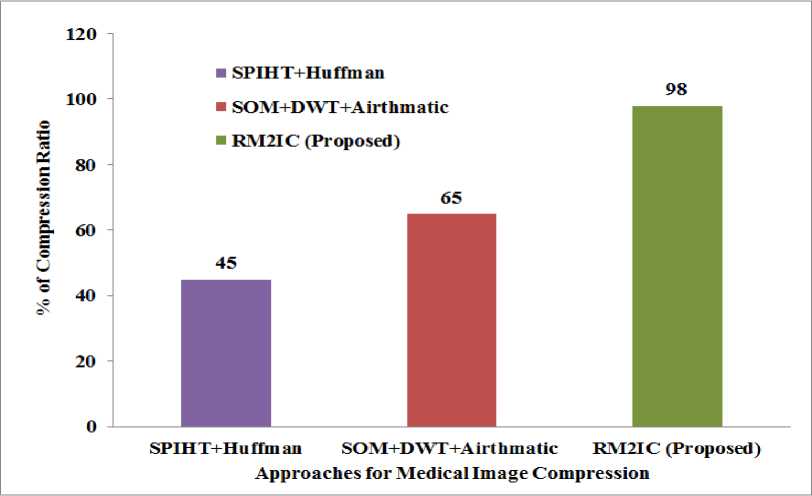
Fig.5. Comparison of different techniques with proposed method in terms of compression ratio.
Fig.5 shows the performance analysis of different hybrid medical image compression techniques is compared with the proposed method in terms of compression ratio. It shows that our proposed method achieves better compression ratio ccompared to other two techniques. Fig.6 shows the performance analysis of different hybrid medical image compression techniques is compared with the proposed method in terms of Peak Signal to Noise Ratio (PSNR. It shows that our proposed method achieves better visual quality of image after reconstructed image compared to other two techniques.
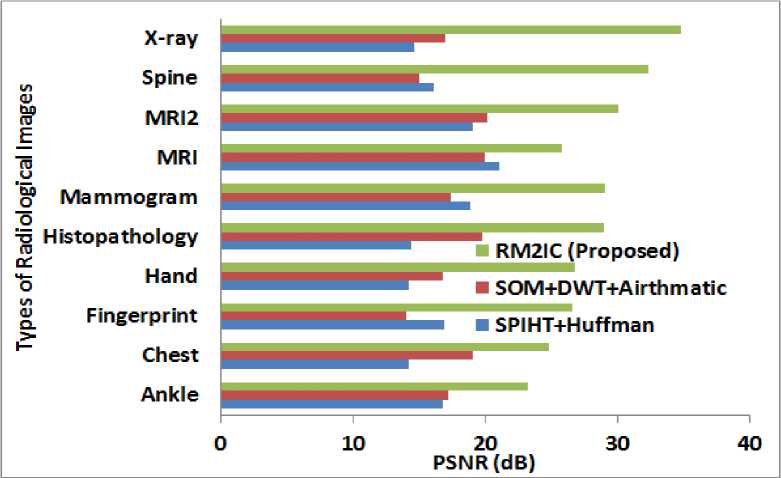
Fig.6. Comparison of various method with proposed scheme in terms of PSNR for many medical images.
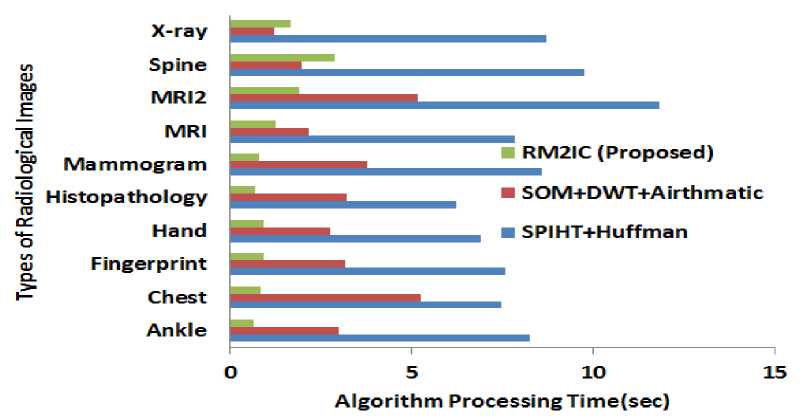
Fig.7. Comparison of various method with proposed scheme in terms of Algorithm processing Time for many medical images.
Table 1. Comparison of various hybrid techniques with proposed method in terms of SSIM and VIF
|
Image |
Structural Similarity Index (SSIM) |
Virtual Information Fidelity (VIF) |
||||
|
SPIHT+ Huffman |
SOM+DWT+ Arithmetic |
Proposed Method |
SPIHT+ Huffman |
SOM+DWT+ Arithmetic |
Proposed Method |
|
|
Ankle |
0.7354 |
0.8658 |
0.9144 |
0.3152 |
0.3498 |
0.3987 |
|
Chest |
0.6085 |
0.7982 |
0.9079 |
0.2359 |
0.2559 |
0.3925 |
|
Fingerprint |
0.7025 |
0.8070 |
0.8967 |
0.2015 |
0.2187 |
0.3879 |
|
Hand |
0.7841 |
0.8125 |
0.8974 |
0.3012 |
0.3368 |
0.3897 |
|
Histopathology |
0.6584 |
0.7895 |
0.8878 |
0.2256 |
0.2320 |
0.4187 |
|
Mammogram |
0.5689 |
0.6989 |
0.8989 |
0.3265 |
0.3562 |
0.3845 |
|
MRI |
0.5997 |
0.7985 |
0.9154 |
0.3025 |
0.3568 |
0.3983 |
|
MRI2 |
0.6665 |
0.8235 |
0.9100 |
0.2456 |
0.2678 |
0.4289 |
|
Spine |
0.6897 |
0.8458 |
0.8954 |
0.2999 |
0.3658 |
0.4004 |
|
X-Ray |
0.7999 |
0.8118 |
0.9231 |
0.3254 |
0.3478 |
0.3891 |
Fig.7 shows the performance analysis of different hybrid medical image compression techniques is compared with the proposed method in terms of algorithm processing time. It shows that our proposed method achieves less processing time compared to other two techniques. Table.1 shows the comparison table for different hybrid techniques for various medical images in terms of SSIM and VIF with proposed methods. The SSIM measures the similarity between the original image and the reconstructed image. Here, we done performance analysis of other two different methods. Method-1 utilizes the Huffman encoding scheme at the most diagnostically important part of the image, and the other non-important part of region is compressed with the conventional SPIHT encoding scheme. Similarly, in method-2 uses the arithmetic encoding method for region of interest and the SOM is applied for non-region part of medical image. But in our proposed method uses the hybrid of JPEG 2000, RLE, Huffman and Arithmetic encoding scheme for important part of medical image compression and background of medical image compressed by the hybrid of compressive sensing methods. The results shows that the proposed method achieves better compression ratio, good visual perception of reconstructed image, very small algorithm processing time for compression and reconstruction of image and finally, it is also compared using SSIM and VIF factor. The proposed method achieves better compared to other two techniques. Similarly, the VIF gives the mutual information between the original image and reconstructed Images.
-
VIII. Conclusion
Compression is very essential process for facilitating cost effective storage system as well as transmitting the medical image in telemedicine application. After reviewing various current research works, we find that the potential of compressive sensing has not been tapped properly. The existing techniques uses compressive sensing mainly for sampling process on new techniques of image acquisition. Hence, we presents a novel modeling where the goodness of lossy and lossless compression is integrated in such a balancing way that the proposed system is found to offer better compression performance. We measure the overall compression performance with an aid of PSNR and response time and found that proposed system excels much better than existing system.
-
[1] X. Xiao, Y. Zhuang, Z. Wang and X. Zhang, "A reconstruction algorithm based on 3D tree-structure Bayesian compressive sensing for underwater videos," 2015 IEEE International Conference on Information and Automation, Lijiang, 2015, pp. 886-891.
-
[2] F. Thakkar and V. K. Srivastava, "Improved compressive sensing for grayscale mages with zigzag scanning and block DCT," 2015 International Conference on Computer, Communication and Control (IC4), Indore, 2015, pp. 1-4.
-
[3] Jiang Yuan, ShenPei, ZhaoPing, DaiJiYang and ChenZhen, "An improved algorithm of search for compressive sensing image recovery based on lp norm," 2015 Chinese Automation Congress (CAC), Wuhan, 2015, pp. 1962-1968.
-
[4] F. C. Chang and H. C. Huang, "The Analysis of Reconstruction Efficiency with Compressive Sensing in Different K-Spaces," 2015 Third International Conference on Robot, Vision and Signal Processing (RVSP), Kaohsiung, 2015, pp. 67-70.
-
[5] N. Eslahi and A. Aghagolzadeh, "Compressive Sensing Image Restoration Using Adaptive Curvelet Thresholding and Nonlocal Sparse Regularization," in IEEE Transactions on Image Processing, vol. 25, no. 7, pp. 3126-3140, July 2016.
-
[6] Lakshminarayana. M and M. Sarvagya, “Scaling the Effectiveness of Existing Compressive Sensing in
Multimedia Contents”, International Journal of Computer Applications, vol. no. 115, no. 9, 2015, pp.16-26.
-
[7] V. Pavithra and S. M. Renuka Devi, "An image
representation scheme by hybrid compressive sensing," 2013 IEEE Asia Pacific Conference on Postgraduate Research in Microelectronics and Electronics (Prime Asia), Visakhapatnam, 2013, pp. 114-119.
-
[8] Ponuma R, Aarthi V and Amutha R, "Cosine Number Transform based hybrid image compression-encryption," 2016 International Conference on Wireless Communications, Signal Processing and Networking (WiSPNET), Chennai, 2016, pp. 172-176.
-
[9] E. Atar, O. K. Ersoy and L. Özyılmaz, "Character/text data compression and encryption by compressive sensing and hybrid cryptography," 2016 24th Signal Processing and Communication Application Conference (SIU), Zonguldak, 2016, pp. 365-368.
-
[10] M. Deriche, M. A. Qureshi and A. Beghdadi, "An image compression algorithm using reordered wavelet
coefficients with compressive sensing," 2015 International Conference on Image Processing Theory, Tools and Applications (IPTA), Orleans, 2015, pp. 498-503.
-
[11] R. Obermeier, J. H. Juesas and J. A. Martinez-Lorenzo, "Imaging breast cancer in a hybrid DBT / NRI system using compressive sensing," 2015 IEEE International Symposium on Antennas and Propagation & USNC/URSI National Radio Science Meeting, Vancouver, BC, 2015, pp. 392-393.
-
[12] E. A. Bernal and Q. Li, "Hybrid vectorial and tensorial Compressive Sensing for hyperspectral imaging," 2015 IEEE International Conference on Acoustics, Speech and Signal Processing (ICASSP), South Brisbane, QLD, 2015, pp. 2454-2458.
-
[13] P. C, S. S. Gorthi and D. Mishra, "Compressive Sensing framework for simultaneous compression and despeckling of SAR images," 2015 Eighth International Conference on Advances in Pattern Recognition (ICAPR), Kolkata, 2015, pp. 1-6.
-
[14] J. Zhang, B. Sun and H. Xu, "Analysis of the effect of sparsity on the performance of SAR imaging based on CS theory," 2016 International Conference on Communication and Signal Processing (ICCSP), Melmaruvathur, Tamilnadu, India, 2016, pp. 0384-0388.
-
[15] A. Thapliyal and R. Kumar, "Temporal compression in wireless sensor networks using compressive sensing and ARMA modeling," 2016 2nd International Conference on Advances in Computing, Communication, & Automation (ICACCA) (Fall), Bareilly, India, 2016, pp. 1-4.
-
[16] B. Yang, H. Xu, Y. You and X. Xie, "The hybrid Cramér-Rao bounds on elevation in compressive sensing SAR tomography," 2016 4th International Workshop on Compressed Sensing Theory and its Applications to Radar, Sonar and Remote Sensing (CoSeRa), Aachen, 2016, pp. 128-132.
-
[17] J. Sevilla, G. Martín, J. Nascimento and J. Bioucas-Dias, "Hyperspectral image reconstruction from random projections on GPU," 2016 IEEE International Geoscience and Remote Sensing Symposium (IGARSS), Beijing, 2016, pp. 280-283.
-
[18] Lakshminarayana. M and M. Sarvagya, 2015, “Lossless Compression of Medical Image to Overcome Network Congestion Constraints”, Springer, Proceedings of Third International Conference on Emerging Research in Computing, Information, Communication and Application (ERCICA-2015), Bangalore, vol. 01, pp.305-311.
-
[19] M. Lakshminarayana and M. Sarvagya, 2015, "Random sample measurement and reconstruction of medical image signal using Compressive Sensing," International Conference on Computing and Network Communications (CoCoNet), Trivandrum, pp. 255-262.
-
[20] Lakshminarayana. M and M. Sarvagya, 2016, “Algorithm to Balance Compression and Signal Quality using Novel Compressive Sensing in Medical Images”, SpringerSoftware Engineering Perspectives and Application in Intelligent Systems, pp.317-327.
-
[21] Lakshminarayana. M and Mrinal Sarvagya, "CARIC: A Novel Modeling of Combinatorial Approach for Radiological Image Compression", Springer, Cybernetics and Mathematics Applications in Intelligent Systems, CSOC-2017, Vol.2, pp.82-91, April-2017.
-
[22] M. V. R. Manimala, C. D. Naidu and M. N. Giriprasad, "Sparse recovery algorithms based on dictionary learning for MR image reconstruction," 2016 International
Conference on Wireless Communications, Signal
Processing and Networking (WiSPNET), Chennai, 2016, pp. 1354-1360.
-
[23] A. S. Unde, R. Malla and Deepthi P. P., "Low complexity secure encoding and joint decoding for distributed compressive sensing WSNs," 2016 3rd International Conference on Recent Advances in Information Technology (RAIT), Dhanbad, 2016, pp. 89-94.
-
[24] Huang Bingchao, Wan JianWei, Xu Ke and Nian Yongjian, "Block compressive sensing of hyperspectral images based on prediction error," 2015 4th International Conference on Computer Science and Network Technology (ICCSNT), Harbin, 2015, pp. 1395-1399.
-
[25] N. Eslahi and A. Aghagolzadeh, "Compressive Sensing Image Restoration Using Adaptive Curvelet Thresholding and Nonlocal Sparse Regularization," in IEEE Transactions on Image Processing, vol. 25, no. 7, pp. 3126-3140, July 2016.
-
[26] "Finding Articles, Databases and Images". Cornell
UniversityLibrary.
les. (Refereed on 03th Dec-2016.
Список литературы RM2IC: Performance Analysis of Region based Mixed-mode Medical Image Compression
- X. Xiao, Y. Zhuang, Z. Wang and X. Zhang, "A reconstruction algorithm based on 3D tree-structure Bayesian compressive sensing for underwater videos," 2015 IEEE International Conference on Information and Automation, Lijiang, 2015, pp. 886-891.
- F. Thakkar and V. K. Srivastava, "Improved compressive sensing for grayscale mages with zigzag scanning and block DCT," 2015 International Conference on Computer, Communication and Control (IC4), Indore, 2015, pp. 1-4.
- Jiang Yuan, ShenPei, ZhaoPing, DaiJiYang and ChenZhen, "An improved algorithm of search for compressive sensing image recovery based on lp norm," 2015 Chinese Automation Congress (CAC), Wuhan, 2015, pp. 1962-1968.
- F. C. Chang and H. C. Huang, "The Analysis of Reconstruction Efficiency with Compressive Sensing in Different K-Spaces," 2015 Third International Conference on Robot, Vision and Signal Processing (RVSP), Kaohsiung, 2015, pp. 67-70.
- N. Eslahi and A. Aghagolzadeh, "Compressive Sensing Image Restoration Using Adaptive Curvelet Thresholding and Nonlocal Sparse Regularization," in IEEE Transactions on Image Processing, vol. 25, no. 7, pp. 3126-3140, July 2016.
- Lakshminarayana. M and M. Sarvagya, “Scaling the Effectiveness of Existing Compressive Sensing in Multimedia Contents”, International Journal of Computer Applications, vol. no. 115, no. 9, 2015, pp.16-26.
- V. Pavithra and S. M. Renuka Devi, "An image representation scheme by hybrid compressive sensing," 2013 IEEE Asia Pacific Conference on Postgraduate Research in Microelectronics and Electronics (Prime Asia), Visakhapatnam, 2013, pp. 114-119.
- Ponuma R, Aarthi V and Amutha R, "Cosine Number Transform based hybrid image compression-encryption," 2016 International Conference on Wireless Communications, Signal Processing and Networking (WiSPNET), Chennai, 2016, pp. 172-176.
- E. Atar, O. K. Ersoy and L. Özyılmaz, "Character/text data compression and encryption by compressive sensing and hybrid cryptography," 2016 24th Signal Processing and Communication Application Conference (SIU), Zonguldak, 2016, pp. 365-368.
- M. Deriche, M. A. Qureshi and A. Beghdadi, "An image compression algorithm using reordered wavelet coefficients with compressive sensing," 2015 International Conference on Image Processing Theory, Tools and Applications (IPTA), Orleans, 2015, pp. 498-503.
- R. Obermeier, J. H. Juesas and J. A. Martinez-Lorenzo, "Imaging breast cancer in a hybrid DBT / NRI system using compressive sensing," 2015 IEEE International Symposium on Antennas and Propagation & USNC/URSI National Radio Science Meeting, Vancouver, BC, 2015, pp. 392-393.
- E. A. Bernal and Q. Li, "Hybrid vectorial and tensorial Compressive Sensing for hyperspectral imaging," 2015 IEEE International Conference on Acoustics, Speech and Signal Processing (ICASSP), South Brisbane, QLD, 2015, pp. 2454-2458.
- P. C, S. S. Gorthi and D. Mishra, "Compressive Sensing framework for simultaneous compression and despeckling of SAR images," 2015 Eighth International Conference on Advances in Pattern Recognition (ICAPR), Kolkata, 2015, pp. 1-6.
- J. Zhang, B. Sun and H. Xu, "Analysis of the effect of sparsity on the performance of SAR imaging based on CS theory," 2016 International Conference on Communication and Signal Processing (ICCSP), Melmaruvathur, Tamilnadu, India, 2016, pp. 0384-0388.
- A. Thapliyal and R. Kumar, "Temporal compression in wireless sensor networks using compressive sensing and ARMA modeling," 2016 2nd International Conference on Advances in Computing, Communication, & Automation (ICACCA) (Fall), Bareilly, India, 2016, pp. 1-4.
- B. Yang, H. Xu, Y. You and X. Xie, "The hybrid Cramér-Rao bounds on elevation in compressive sensing SAR tomography," 2016 4th International Workshop on Compressed Sensing Theory and its Applications to Radar, Sonar and Remote Sensing (CoSeRa), Aachen, 2016, pp. 128-132.
- J. Sevilla, G. Martín, J. Nascimento and J. Bioucas-Dias, "Hyperspectral image reconstruction from random projections on GPU," 2016 IEEE International Geoscience and Remote Sensing Symposium (IGARSS), Beijing, 2016, pp. 280-283.
- Lakshminarayana. M and M. Sarvagya, 2015, “Lossless Compression of Medical Image to Overcome Network Congestion Constraints”, Springer, Proceedings of Third International Conference on Emerging Research in Computing, Information, Communication and Application (ERCICA-2015), Bangalore, vol. 01, pp.305-311.
- M. Lakshminarayana and M. Sarvagya, 2015, "Random sample measurement and reconstruction of medical image signal using Compressive Sensing," International Conference on Computing and Network Communications (CoCoNet), Trivandrum, pp. 255-262.
- Lakshminarayana. M and M. Sarvagya, 2016, “Algorithm to Balance Compression and Signal Quality using Novel Compressive Sensing in Medical Images”, Springer-Software Engineering Perspectives and Application in Intelligent Systems, pp.317-327.
- Lakshminarayana. M and Mrinal Sarvagya, "CARIC: A Novel Modeling of Combinatorial Approach for Radiological Image Compression", Springer, Cybernetics and Mathematics Applications in Intelligent Systems, CSOC-2017, Vol.2, pp.82-91, April-2017.
- M. V. R. Manimala, C. D. Naidu and M. N. Giriprasad, "Sparse recovery algorithms based on dictionary learning for MR image reconstruction," 2016 International Conference on Wireless Communications, Signal Processing and Networking (WiSPNET), Chennai, 2016, pp. 1354-1360.
- A. S. Unde, R. Malla and Deepthi P. P., "Low complexity secure encoding and joint decoding for distributed compressive sensing WSNs," 2016 3rd International Conference on Recent Advances in Information Technology (RAIT), Dhanbad, 2016, pp. 89-94.
- Huang Bingchao, Wan JianWei, Xu Ke and Nian Yongjian, "Block compressive sensing of hyperspectral images based on prediction error," 2015 4th International Conference on Computer Science and Network Technology (ICCSNT), Harbin, 2015, pp. 1395-1399.
- N. Eslahi and A. Aghagolzadeh, "Compressive Sensing Image Restoration Using Adaptive Curvelet Thresholding and Nonlocal Sparse Regularization," in IEEE Transactions on Image Processing, vol. 25, no. 7, pp. 3126-3140, July 2016.
- "Finding Articles, Databases and Images". Cornell UniversityLibrary. https://www.library.cornell.edu/research/introduction/articles. (Refereed on 03th Dec-2016.

